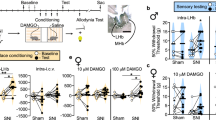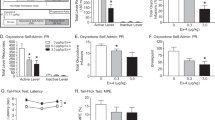Abstract
THE identification in brain of opiate receptors1 and morphine-like pentapeptides (methionine-enkephalin and leucine-enkephalin)2 has led to suggestions that enkephalin receptors may be sites at which opiate drugs induce analgesia and euphoria, and that the enkephalins themselves may be transmitters or modulators in brain systems for the regulation of pain and pleasure3–6. Observations in animals reveal that appropriate central administration of enkephalin produces morphine-like analgesia7–9 and physical dependence10. We report here that enkephalin also may share the euphorigenic or rewarding properties of morphine in that rats will work for enkephalin injections delivered directly into the ventricles of their own brains11. Of particular interest, in the light of the generally superior potency of the methionine peptide2,8,9, is the observation that leucine-enkephalin is self-administered with greater avidity than methionine-enkephalin.
This is a preview of subscription content, access via your institution
Access options
Subscribe to this journal
Receive 51 print issues and online access
$199.00 per year
only $3.90 per issue
Buy this article
- Purchase on Springer Link
- Instant access to full article PDF
Prices may be subject to local taxes which are calculated during checkout
Similar content being viewed by others
References
Goldstein, A. Science 193, 1081–1086 (1976).
Hughes, J. et al. Nature 258, 577–579 (1975).
Kosterlitz, H. W. & Hughes, J. Life Sci. 17, 91–96 (1975).
Liebeskind, J. D., Giesler, G. J. & Urca, G. in Sensory Functions of the Skin (ed. Zotterman, Y.) 561–573 (Pergamon, Oxford, 1976).
Snyder, S. H. Nature 257, 185–189 (1975).
Byck, R. Lancet ii, 72–73 (1976).
Belluzzi, J. D. et al. Nature 260, 625–626 (1976).
Buscher, H. H. et al. Nature 261, 423–425 (1976).
Chang, J-K., Fong, B. T. N., Pert, A. & Pert, C. Life Sci. 18, 1473–1482 (1976).
Wei, E. & Loh, H. Sciences 193, 1262 (1976).
Belluzzi, J. D., Wise, C. D. & Stein, L. Neurosci. Abstr. 2, 564 (1976).
Amit, Z., Brown, Z. W. & Sklar, L. S. Psychopharmacology 48, 291–294 (1976).
Simantov, R. & Snyder, S. H. Life Sci. 18, 781–788 (1976).
German, D. C. & Bowden, D. M. Brain Res. 73, 381 (1974).
Elde, R., Hökfelt, T., Johansson, O. & Terenius, L. Neuroscience 1, 349–352 (1976).
Mayer, D. J., Wolfe, T. L., Akil, H., Carder, B. & Liebeskind, J. C. Science 174, 1351–1354 (1971).
Versteeg, D. H. G., Van DerGugten, J., DeJong, W. & Palkovits, M. Brain Res. 113, 563–574 (1976).
Stein, L., Belluzzi, J. D. & Wise, C. D. in Brain-Stimulation Reward (eds Wauquire, A. & Rolls, E. T.) 297–331 (North-Holland, Amsterdam, 1976).
Pozuelo, J. & Kerr, F. W. L. Mayo Clin. Proc. 47, 621–628 (1972).
Davis, W. M., Smith, S. G. & Khalsa, J. H. Pharmac. Biochem. Behav. 3, 477–484 (1975).
Crow, T. J. Psychol. Med. 3, 66–73 (1973).
Author information
Authors and Affiliations
Rights and permissions
About this article
Cite this article
BELLUZZI, J., STEIN, L. Enkephalin may mediate euphoria and drive-reduction reward. Nature 266, 556–558 (1977). https://doi.org/10.1038/266556a0
Received:
Accepted:
Issue Date:
DOI: https://doi.org/10.1038/266556a0
This article is cited by
-
Neuromodulation in Parkinson’s disease targeting opioid and cannabinoid receptors, understanding the role of NLRP3 pathway: a novel therapeutic approach
Inflammopharmacology (2023)
-
‘Naltrexone Blocks Endorphins Released when Dancing in Synchrony’
Adaptive Human Behavior and Physiology (2017)
-
Light and electron-microscopic study of leucine enkephalin immunoreactivity in the cat claustrum
Journal of Molecular Histology (2012)
-
Pharmacological Evidence for a Motivational Role of κ-Opioid Systems in Ethanol Dependence
Neuropsychopharmacology (2008)
-
The role of beta-endorphin in the acute motor stimulatory and rewarding actions of cocaine in mice
Psychopharmacology (2008)
Comments
By submitting a comment you agree to abide by our Terms and Community Guidelines. If you find something abusive or that does not comply with our terms or guidelines please flag it as inappropriate.



